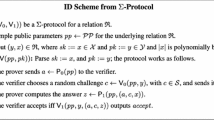Abstract
Side-channel attacks are a major threat for cryptographic mechanisms; yet, they are not considered in the computational model that is used by cryptographers for proving the security of their schemes. As a result, there are several efficient attacks against standardized implementations of provably secure schemes. Leakage resilient cryptography aims to extend provable security so that it can account for side-channels. There are several models of leakage resilient cryptography, from very general models such as physically observable cryptography, to more specialized models that aim to account for a specific form of covert channel. The Bounded Storage model (BSM) is a such a specialized model, which focuses on situations where a virus or a malware program forwards to the attacker some information stolen from the infected computer’s memory, for instance some share of a long-term key.
We adapt the Computational Indistinguishability Logic to account the BSM, and show how the resulting formalism can be used to verify an existing key exchange protocol in the BSM. Our work provides the first formalism to reason about leakage resilient cryptography.
Access this chapter
Tax calculation will be finalised at checkout
Purchases are for personal use only
Preview
Unable to display preview. Download preview PDF.
Similar content being viewed by others
References
Alwen, J., Dodis, Y., Wichs, D.: Survey: Leakage Resilience and the Bounded Retrieval Model. In: Kurosawa, K. (ed.) Information Theoretic Security. LNCS, vol. 5973, pp. 1–18. Springer, Heidelberg (2010)
Barthe, G., Daubignard, M., Kapron, B., Lakhnech, Y.: Computational indistinguishability logic. In: Proceedings of the 17th ACM Conference on Computer and Communications Security. ACM (2010)
Barthes, G., Duclos, M., Lakhnech, Y.: A computational indistinguishability logic for the bounded storage model. Technical report, Verimag, IMDEA Software (2011)
Barthe, G., Grégoire, B., Béguelin, S.Z.: Formal certification of code-based cryptographic proofs. In: Proceedings of POPL 2009, pp. 90–101 (2009)
Blanchet, B.: A computationally sound mechanized prover for security protocols. In: IEEE Symposium on Security and Privacy, pp. 140–154 (2006)
Bellare, M., Rogaway, P.: The Exact Security of Digital Signatures - How to Sign with RSA and Rabin. In: Maurer, U.M. (ed.) EUROCRYPT 1996. LNCS, vol. 1070, pp. 399–416. Springer, Heidelberg (1996)
Bellare, M., Rogaway, P.: The Exact Security of Digital Signatures - How to Sign with RSA and Rabin. In: Maurer, U.M. (ed.) EUROCRYPT 1996. LNCS, vol. 1070, pp. 399–416. Springer, Heidelberg (1996)
Cortier, V., Kremer, S., Warinschi, B.: A survey of symbolic methods in computational analysis of cryptographic systems. J. Autom. Reasoning, 1–35 (2010)
Datta, A., Derek, A., Mitchell, J.C., Warinschi, B.: Computationally sound compositional logic for key exchange protocols. In: Proceedings of CSFW 2006, pp. 321–334 (2006)
Dziembowski, S., Maurer, U.: Optimal randomizer efficiency in the bounded-storage model. Journal of Cryptology 17(1), 5–26 (2004)
Dziembowski, S., Pietrzak, K.: Leakage-resilient cryptography. In: IEEE 49th Annual IEEE Symposium on Foundations of Computer Science, FOCS 2008, pp. 293–302 (2008)
Dziembowski, S.: Intrusion-Resilience Via the Bounded-Storage Model. In: Halevi, S., Rabin, T. (eds.) TCC 2006. LNCS, vol. 3876, pp. 207–224. Springer, Heidelberg (2006)
Goldwasser, S., Micali, S.: Probabilistic encryption* 1. Journal of Computer and System Sciences 28(2), 270–299 (1984)
Impagliazzo, R., Kapron, B.M.: Logics for reasoning about cryptographic constructions. Journal of Computer and Systems Sciences 72(2), 286–320 (2006)
Kocher, P.C.: Timing Attacks on Implementations of Diffie-Hellman, RSA, DSS, and Other Systems. In: Koblitz, N. (ed.) CRYPTO 1996. LNCS, vol. 1109, pp. 104–113. Springer, Heidelberg (1996)
Kiltz, E., Pietrzak, K.: Leakage Resilient ElGamal Encryption. In: Abe, M. (ed.) ASIACRYPT 2010. LNCS, vol. 6477, pp. 595–612. Springer, Heidelberg (2010)
Maurer, U.M.: Conditionally-perfect secrecy and a provably-secure randomized cipher. Journal of Cryptology 5(1), 53–66 (1992)
Micali, S., Reyzin, L.: Physically Observable Cryptography. In: Naor, M. (ed.) TCC 2004. LNCS, vol. 2951, pp. 278–296. Springer, Heidelberg (2004)
Micali, S., Reyzin, L.: Physically Observable Cryptography (Extended Abstract). In: Naor, M. (ed.) TCC 2004. LNCS, vol. 2951, pp. 278–296. Springer, Heidelberg (2004)
Rogaway, P., Bellare, M.: Optimal asymmetric encryption how to encrypt with rsa (1995)
Zhang, Y.: The computational SLR: a logic for reasoning about computational indistinguishability. IACR ePrint Archive 2008/434 (2008); Also in Proc. of Typed Lambda Calculi and Applications 2009
Author information
Authors and Affiliations
Editor information
Editors and Affiliations
Rights and permissions
Copyright information
© 2012 Springer-Verlag Berlin Heidelberg
About this paper
Cite this paper
Barthe, G., Duclos, M., Lakhnech, Y. (2012). A Computational Indistinguishability Logic for the Bounded Storage Model. In: Garcia-Alfaro, J., Lafourcade, P. (eds) Foundations and Practice of Security. FPS 2011. Lecture Notes in Computer Science, vol 6888. Springer, Berlin, Heidelberg. https://doi.org/10.1007/978-3-642-27901-0_9
Download citation
DOI: https://doi.org/10.1007/978-3-642-27901-0_9
Publisher Name: Springer, Berlin, Heidelberg
Print ISBN: 978-3-642-27900-3
Online ISBN: 978-3-642-27901-0
eBook Packages: Computer ScienceComputer Science (R0)




